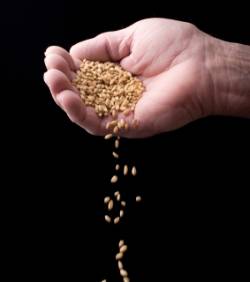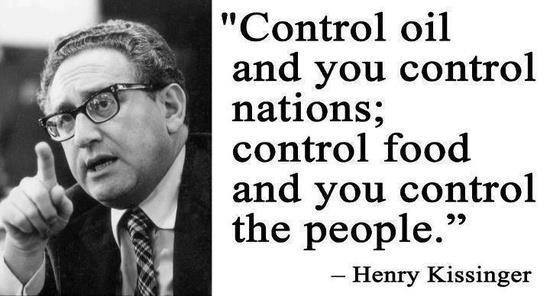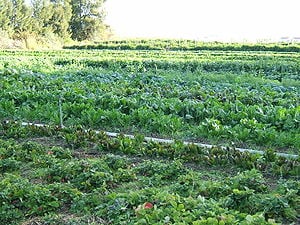Global Agribusiness and the Marginalisation of Self-Sufficient Organic Farming and Agroecology

Is
organic-based farming merely a niche model of agriculture that is not
capable of feeding the global population? Or does it have a major role
to play?
In
addressing these questions, it would be useful to consider a selection
of relevant literature to see what it says about the role of organic farming, how this model of agriculture impacts farmers and whether or not it can actually feed the global population.
Organic farming and sustainable livelihoods
In ‘The impact of organic farming on food security in a regional and global perspective’,
Halberg et al (2006) argue that while present food production in theory
is sufficient to cover the energy and protein needs of the global
population, there are still more than 740 million food insecure people,
the majority of whom live in the Global South. The researchers indicate
that if a conversion to organic farming of approximately 50% of the
agricultural area in the Global South were to be carried out, it would
result in increased self-sufficiency and decreased net food import to
the region.
Following on from this, in the 2013 book ‘Organic Agriculture for Sustainable Livelihioods’
by Halberg and Muller, the authors suggest that organic crops tend to
provide farmers with a higher net income compared to their conventional
counterparts due to lower production costs. The book provides convincing
evidence that organic farming has a positive influence on smallholder
food security and livelihoods. This is important because smallholder
agriculture is key to food production in the Global South, where food insecurity is most prevalent.
Aaron Iverson makes
a pertinent point about this book: Halberg and Muller factor into their
analyses the economic benefits of organic agriculture over conventional
agriculture, which accrue over several years to decades. Iverson says
that such analyses on these time scales are rare. Based on extensive
research and modelling, the two authors indicate that organic farming
promotes crop diversity, improves worker health due to less chemical
exposure, increases social and human capital, increases farmland
biodiversity, lowers pollution, increases soil fertility and is less
financially risky due to lower upfront costs. Among other things, it
also sequesters more soil carbon and is less vulnerable to climate
change due to improved soil properties.
UN FAO: organic could feed the world
In 2007, the UN FAO (Food and Agriculture Organization) noted that
the advantage of organic agriculture is that it relies on fossil-fuel
independent and locally-available production assets. Organic models work
with natural processes, increase cost-effectiveness and contribute to
resilience in the face of climatic stress. The FAO concluded that by
managing biodiversity in time (rotations) and space (mixed cropping),
organic farmers use their labour and environmental factors to intensify
production in a sustainable way and that organic agriculture could break
the vicious circle of indebtedness for agricultural inputs, which
causes an alarming rate of farmers’ suicides.
 The
FAO recognises that agroecology contributes to improved food
self-reliance, the revitalisation of smallholder agriculture and
enhanced employment opportunities. It asserts that organic agriculture
could produce enough food on a global per capita basis for the current
world population but with reduced environmental impact than conventional
agriculture.
The
FAO recognises that agroecology contributes to improved food
self-reliance, the revitalisation of smallholder agriculture and
enhanced employment opportunities. It asserts that organic agriculture
could produce enough food on a global per capita basis for the current
world population but with reduced environmental impact than conventional
agriculture.
In a similar vein, although not focusing solely on organic, Jules Pretty et al note
that sustainable, resource-conserving agriculture has the potential to
significantly increase yields. It also improves nutrition, food security
and crop diversity (contrast this with what Daniel Miangi says about the chemical-intensive mono-cropping system and its adverse impact on diet).
UN Special Rapporteur on agroecology and the right to food
Olivier De Schutter, former UN special Rapporteur on the right to food, produced this report in 2011 that was based on an extensive review of recent scientific literature. He concludes that, by applying agroecological principles to
the design of democratically controlled agricultural systems, we can
help to put an end to food crises and address climate-change and poverty
challenges. He is not the only one who asserts organic farming is
better suited to addressing climate-related challenges. This peer-reviewed
paper also argues that organic is a “concrete and sustainable option”
for adapting to climate change and variability.
De Schutter argues that agroecological
approaches could address food needs in critical regions and could double
food production in 10 years.
His
report focussed on regions like Africa and South East Asia and showed
an average crop yield increase of 80% in 57 developing countries, with
an average increase of 116% for all African projects. Recent projects
conducted in 20 African countries demonstrated a doubling of crop yields
over a period of 3-10 years. However, De Schutter notes insufficient
backing for organic-based farming seriously hinders progress.
And this last point should not be
understated. For instance, the success of the green revolution is often
touted, but how can we really evaluate it? If alternatives had been
invested in to the same extent, if similar powerful and influential
interests had invested in organic-based models, would we now not be
pointing to the runaway successes of organic-based farming and,
importantly, without the massive external costs of a polluted
environment, less diverse diets, degraded soils and nutrient deficient
food, ill health and so on?
And if green revolution technology and thinking had not been wedded to and fuelled and driven by powerful commercial and geopolitical interests, would it not have been employed more judiciously to serve farmers and the public better?
UNCTAD: better incomes and food availability
In 2012, the Deputy Secretary General of the UN Conference on Trade and Development (UNCTAD), Petko Draganov, during the opening of the 2nd African Organic Conference in the Zambian capital, Lusaka, stated:
“Organic agriculture can offer an impressive array of food security, economic, environmental, and health benefits for developing countries, including in Africa.”
 He
went on to state that expanding Africa’s shift towards organic farming
will have beneficial effects on the continent’s nutritional needs, the
environment, farmers’ incomes, markets and employment.
He
went on to state that expanding Africa’s shift towards organic farming
will have beneficial effects on the continent’s nutritional needs, the
environment, farmers’ incomes, markets and employment.
According to UNCTAD,
organic agriculture can increase farm yields markedly and help farmers
receive higher prices for their produce, which sells at a premium. The
method also helps create jobs in rural areas.
A meta analysis conducted
by UNEP–UNCTAD (2008) assessed 114 cases in Africa. In Kenya, maize
yields increased by 71% and bean yields by 158%. Increased diversity in
food crops available to farmers resulted in more varied diets and thus
improved nutrition. The 114 projects covered 2 million hectares and 1.9
million farmers showing a 116% higher average crop yield on average for
all African projects and 128 higher for the projects in East Africa. The
UN agencies concluded that organic agriculture can be more conducive to
food security in Africa than most conventional production systems and
that it is more likely to be sustainable in the long term. These
projects increased food availability for local people and gave the
farmers involved higher incomes.
IAASTD recommends agroecology
The IAASTD peer-reviewed report,
produced by 400 scientists and supported by 60 countries, recommends
agroecology to maintain and increase the productivity of global
agriculture. It cites the largest study of sustainable agriculture in
the Global South, which analysed 286 projects covering 37 million
hectares in 57 countries, and found that on average crop yields
increased by 79% (the study by Pretty et al, referred to earlier – which
includes ‘resource conserving’ non-organic conventional approaches).
The
purpose of listing these reports is to show that there is enough
evidence to demonstrate that organic-based approaches are vital for
guaranteeing food security, rural development, better nutrition and
sustainability, especially in the Global South.
The Cuban model
Aside from the evidence provided above,
there are numerous other studies which testify to the efficacy of
organic farming: for example, there are reports/studies from the Rodale Institute, Oakland Institute, Women’s Collective of Tamil Nadu, Newcastle University, UN Green Economy Initiative and Washington State University. We also need look no further than the results of organic-based farming in Malawi. Organic approaches have also enhanced farmers’ livelihoods in India and play a key role in contributing to rural development.
However, if we want to really appreciate
what happens when a major widespread shift to organic farming occurs,
we need look no further than Cuba.
Cuba is the one country in the world
that has made the biggest changes in the shortest time in moving from
industrial chemical-intensive agriculture to organic farming.
Miguel Altieri notes
that, due to the difficulties Cuba experienced as a result of the fall
of the USSR, it moved towards organic and agroecological techniques in
the 1990s. Thousands of oxen replaced tractors that could not function
due to lack of petroleum and spare parts. Farmers substituted green
manures for chemical fertilizers and artisanally produced biopesticides
for insecticides.
Altieri states that from 1996 to 2005, per capita food production in Cuba increased by 4.2 percent yearly during
a period when production was stagnant across the wider region. In the
mid-2000s, the Ministry of Agriculture endorsed the creation of 2,600
new small urban and suburban farms and allowed farming on some three
million hectares of unused state lands.
Today Cuba has 383,000 urban farms,
covering 50,000 hectares of otherwise unused land and producing more
than 1.5 million tons of vegetables. The most productive urban farms
yield up to 20 kg of food per square meter, the highest rate in the
world, using no synthetic chemicals. Urban farms supply 50 to 70 percent or more of all the fresh vegetables consumed in cities such as Havana and Villa Clara.
Altieri and his colleague have calculated that
if all peasant farms and cooperatives adopted diversified
agroecological designs, Cuba would be able to produce enough to feed its
population, supply food to the tourist industry and even export some
food to help generate foreign currency.
What Cuba has done is a major achievement, as Garry Leech argues:
“The shift to a more ecologically sustainable agricultural production has resulted in healthy organic food being the most convenient and inexpensive food available to Cubans. Because of the US blockade, processed foods are more expensive and not readily available. This reality stands in stark contrast to that in wealthy capitalist nations such as the United States and Canada where heavily-subsidized agri-businesses flood the market with cheap, unhealthy processed foods while organic alternatives are expensive and more difficult to obtain. The consequence in the United States is high levels of obesity, diabetes and heart disease.”
Cuba shows what can be done (see how it was done and
the dangers it now faces) when the political will exists and what
should be done if we are to move away from an unsustainable model of
agriculture that creates food insecurity, environmental degradation, bad
food and ill health.
The US model
Contrast this with what NAFTA did to Mexico.
Driven by an industrial chemical-intensive US model of food processing,
retail and agriculture, the outcome has been bad health, the
undermining of food security and the devastation of small farmers and
businesses.
Processed junk food ridden with toxins and a propped up agribusiness
sector with subsidies has become a feature of the US chemical-intensive
model of agriculture, which has led to all kinds of health and
environmental problems in the US, as highlighted here.
For
Olivier De Schutter, a programme that deals effectively with hunger and
malnutrition has to focus on Mexico’s small farmers and peasants. They
constitute a substantial percentage of the country’s poor and are the
ones that can best supply both rural and urban populations with
nutritious foods.
And the writing is on the wall for places like India too as the neoliberal invasion and
transnational agribusiness armed with its chemicals (and GMOs)
increases its hold over food and agriculture. It is turning out to be disastrous for Indian farmers, the environment and the health of the public (see this too).
In the meantime, supporters of the
unhealthy, unsustainable, industrialised petro-chemical model of
agriculture wish to continue to rip up indigenous agriculture and recast
it accordingly. And they attempt to justify this by stating there is no
alternative and that organic-based approaches, including a genuine democratic-participatory movement like agroecology, cannot deliver.
Despite places like Russia, Cuba and Sikkim (India’s first fully organic state) are showing the way forward, these supporters would say that, wouldn’t they?
From NAFTA and trade agreements like the Knowledge Initiative on Agriculture (India), TTIP and TPP to the ongoing infiltration of Africa by
Bill Gates and ‘corporate America’, they require business as usual: to
offer governments strings-attached loans and ensure export cash-crop
monocropping takes hold (see this articlefrom 1999 about India), to make farmers reliant on external inputs, to get them onto a highly profitable but unsustainable GMO/chemical treadmill and
to incorporate them into an system of globalisation centred on rigged
trade, debt traps and the manipulated international ‘free’ market.
And
all for what? To capture the entire supply chain from seed to plate, to
serve the commercial interests of transnational agritech/agribusiness
and food retail corporations and to use agriculture as a political tool
to create dependency. All of this at the expense of self-sufficiency, sustainable indigenous agriculture and the livelihoods of
those involved in traditional food production, processing and retail.
And all of this too at the expense of regional food security, the
environment and a nutritious, healthy and diverse diet.
The original source of this article is Global Research
Copyright © Colin Todhunter, Global Research, 2016
No comments:
Post a Comment